
■ Heading- Once Aoyama street small shops had been chosen eaves chock
- Changes in the quality of the city through the post-war reconstruction
· 2-chome, born from the "city planning type" eco-project
- Not thrown into the flow of the times, walk its own line "2-chome Culture"
Click to area information ※ will be displayed
Sandwiched between Aoyama and Roppongi, Shibuya and Aoyama, Omotesando, Roppongi and, access to one of the most stylish city Tokyo "Seigaku - Shibuya chome area". From Shibuya Station, Meiji-dori, and further Aoyama, also a thing that separates the two big street of, but unrelated to the area and in front of the station hustle and bustle. Own culture in the calm streets home to Aoyama Gakuin University is alive and tease the history of this area.
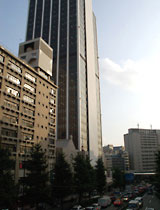
State of Aoyama Street in front to join to the Roppongi Street. It is seen in the left hand cross Tower.
From Shibuya Station to National Highway 246 to the Aoyama district. Shibuya of the triangle of the cross tower to Aoyama Gakuin University, which is sandwiched in Aoyama Street and Roppongi Street branch to the origin area's Shibuya 2-chome. Some of the calm streets, and the city and Shibuya of young people, this region of the adult of the city Aoyama culture are everywhere has its own air to mix. If if I compare the Aoyama Avenue and Roppongi street to the river, this area is fast Shibuya and Aoyama of the streets of the transition, it might be said to further such area as the delta where the culture that has been carried from such deposit Roppongi. This area - let's stroll called "blue science Shibuya chome area".
When it was a children's playground
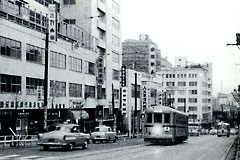
January Aoyama 1960. Toden is running towards the front Aoyama garage Shibuya Station on the back. Tomoegawa Torusoku al., "Nostalgia of train and train Shibuya and its peripheral" than (Tamagawa newspaper published by Co., Ltd.)
Aoyama street sense of good shopping and dining options is enter one's eaves is currently, the Edo era, been developed as a pilgrimage route to the Kanagawa Prefecture, west of Oyama, it had been referred to as the "Oyama Road". 1911 (Meiji 44) years, Shibuya, Tokyo tram (Tokyo metropolitan streetcar after) - between Aoyama garage is open. The Aoyama garage, was in the current National Children's Castle and the United Nations University of place, thing of the streetcar of the garage. In addition 1938 to the (1938) year, Shibuya - subway was opened between the Omotesando. Do Aoyama Street at the time, what kind of cityscape had spread. According to the author Michiko Taguchi that Cascia sight of this region over the post-war from before the war, "Tokyo Aoyama 1940 even sun fell morning will come", Aoyama Street as a single car pass by on both sides pass each other the tram it seems to have been the narrow streets of. And, on both sides of the road, until around the Aoyama 1-chome from Shibuya, that small shops had been chosen eaves closely. "Foodstuffs, of course, tobacco to geta, kimono, radio, such as stationery, there specialty stores in myriad, what you need to immediate life was set anything. When I was a child, have been Hashirasa to your well it was better. since the road car was almost no running, boys place the Brad on top of the tram rails, there is also sightseeing to have storage from playing crushed to Pettanko under the weight of the train (laughs ) "
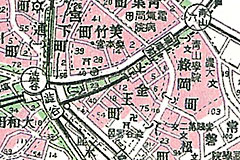
"Concise Tokyo 35 wards division atlas war disappearance zone display" (day land Publishing Co. published) than gold king town and the written part overlaps with the current of Shibuya 2-chome, 3-chome. Pink part was destroyed by all war damage. © Zenrin Map Museum
Even in such an idyllic scene, so gradually drifting heavily is sign of war. Taguchi is towards the current of Yoyogi Park that had parade ground, that was often seen soldiers of the platoon to march the Aoyama Street. It sounded the "Zach, Zach and, regular footsteps, to the sight of Mr. soldier carrying a gun and rucksack march there was a force at the time unique. When the sound is heard," It's soldiers! ", Table in is what saw off until no visible figure jump out. " And, 1941 Taguchi was a fourth grade elementary school, rush to the Pacific War. 1945 May 25, Shibuya, Aoyama The area is attacked by a large air raid (uptown air raid), it became burnt ruins overnight. Aoyama Gakuin University (then Aoyama Gakuin industrial vocational school) destroyed 70% of the building, on both sides of the road from the temple Miyamasuzaka to Aoyama 1-chome, burned body of the victims have been recorded to have been tumbling. Upon return from Taguchi is 3 months after the evacuation away from the end of the war, although the only residential area of the street to the home of there was was left burnt barely, that Aoyama the city ruins, had begun falling a barracks.
It transformed the city the opportunity the Tokyo Olympics
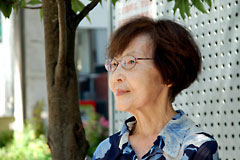
Michiko Taguchi
Followed by the post-war reconstruction, is along the road of Aoyama came back is trickle down and store. It had changed the scene of this area, Tokyo Olympic Games of 1964. In momentum reminiscent of the entire Shibuya Beijing today, the development of the steep pitch advances, the road width of Aoyama also been extended to the earlier of nearly twice the 40 meters, has been in place also Roppongi Street. Then, with the advent of the automobile society, in 1968 the tram is abolished. Gradually shops disappeared, the former life realism sight far, is transformed into one of the most fashionable areas in Tokyo -. Still, that Taguchi's also now walk the peripheral Aoyama, it is driven to Emoiwa enchanting nostalgia. "" I came across a bully in the alley per Do, "" this there was a tobacco shop here, was Kke "and such is the Tosenbo, streets are also changed, revived the memory as long as there is a once running around road ". As former life realism sight like a lie, now also in this area Shibuya, Aoyama, has continued to evolve under the influence of culture, such as Roppongi.
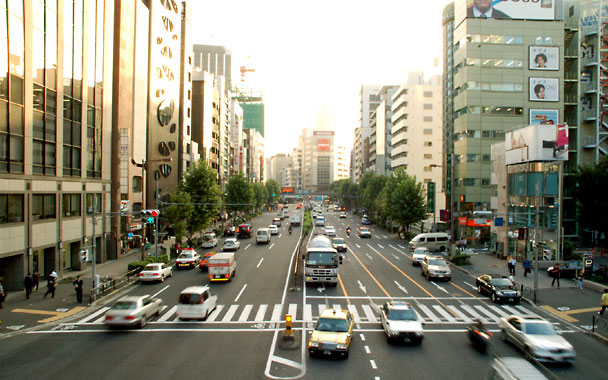
Aoyama of the wide-membered road that one-sided four-lane.
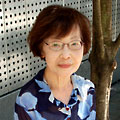
Michiko Taguchi
1932, turf District (now Minato-ku, Tokyo) was born. Go to Minato Ward Seinan elementary school near Omotesando Station. 1954, after graduating from Keio University Faculty of Letters, worked in publishing company, involved in the editing of books and magazines. After marriage, free of the editor, working as a writer. In the book, his diary was spelled Aoyama state of the through during the war, after the war before the war on the basis of "even if the Tokyo Aoyama 1940 yang fell morning will come." "Showa prewar Tokyo district and the Life" (tentative title), the publication schedule.